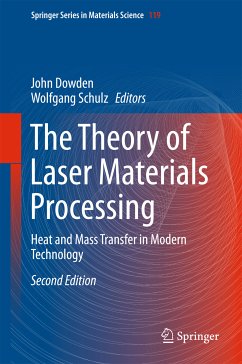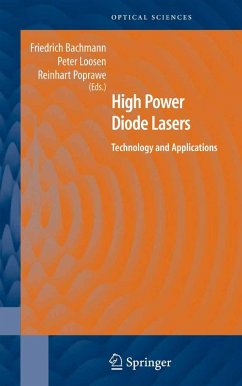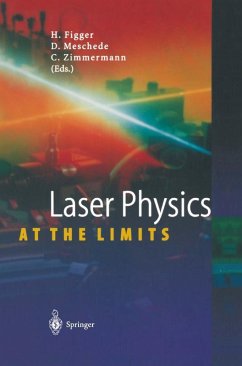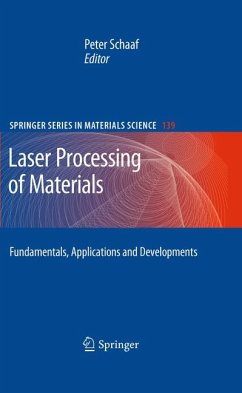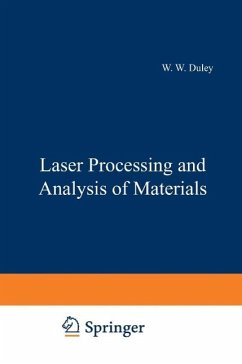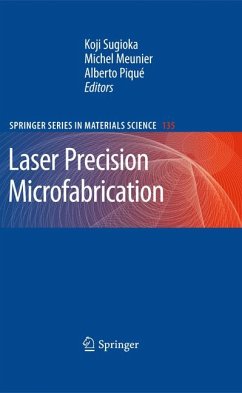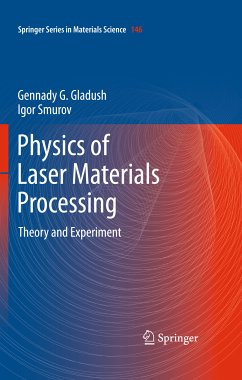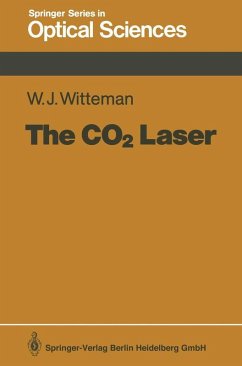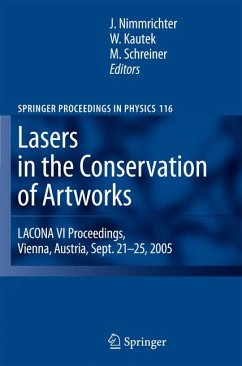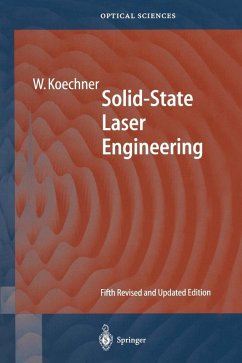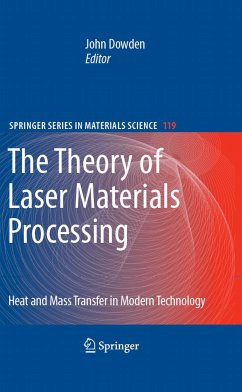
The Theory of Laser Materials Processing (eBook, PDF)
Heat and Mass Transfer in Modern Technology
Redaktion: Dowden, John

PAYBACK Punkte
60 °P sammeln!
themselveswithouttheaidofacalculatorseemstobepassingintohistory, vi Preface butitisanimportantoneandprovidesasimpleanalogy. Ifsomeonedoes nothaveafeelingfornumbersandthewayarithmeticworks,theywillalltoo easilyfailtospotanerrorproducedbyamachine. Computersarenotinfallible -andneitherarethosewhobuildorprogramthem. Computersarenow takingonlessmundanemathematicaltasksandthesamecontroversiesare appearinginconnectionwithalgebraicmanipulation. Equally,andwitheven greaterpenaltiesintermsofcostintheeventoferrors,thesameconsiderations applytonumericalsimulationofmajorindustrialprocesses. Awarenessofthe ...
themselveswithouttheaidofacalculatorseemstobepassingintohistory, vi Preface butitisanimportantoneandprovidesasimpleanalogy. Ifsomeonedoes nothaveafeelingfornumbersandthewayarithmeticworks,theywillalltoo easilyfailtospotanerrorproducedbyamachine. Computersarenotinfallible -andneitherarethosewhobuildorprogramthem. Computersarenow takingonlessmundanemathematicaltasksandthesamecontroversiesare appearinginconnectionwithalgebraicmanipulation. Equally,andwitheven greaterpenaltiesintermsofcostintheeventoferrors,thesameconsiderations applytonumericalsimulationofmajorindustrialprocesses. Awarenessofthe analyticalsolutionscanbeinvaluableindistinguishingtherightfromthe wrong,i. e. forthepractitionertounderstandthebasisofthework,andto haveanideaofthekindsofoutcomesthatareplausible-andtorecognise thosewhicharenot. Thephrase"mathematicalmodelling"is,however,ambiguous,perhaps morenowthanithaseverbeen. Thereisanenormousamountofworkdone todayonsimulationbasedontheuseofverypowerfulcomputerprograms, anditisquitecorrectlyreferredtoasmathematicalmodelling. Theprograms aresometimesconstructedin-housebutareusuallycommercialpackages. This isanentirelyvalidapproachwithspeci?c(generallycommercial)objectives. Ingeneraltherearetwouses. Thedominantobjectiveisnumericalagreement withaparticularexperimentinthe?rstinstance,leadingtopredictivec- mercialuseinthesecondinstance. Thesecondobjectiveistheclari?cation ofphysicalmechanisms,aimedatthegenerationofunderstandingofcomplex interconnectedprocesses,ratherthantheexactreproductionofaparticular experiment. Itissometimesoverlookedthat,withsu?cientcare,anum- icalapproachisequallyvalidintheinvestigationofphysicalfundamentals. Numericalsimulationisnotacentraltopicofthisbook,butbecauseofits crucialimportancetoeachofthetwousestowhichnumericalmodellingcan beput,itisvitalthatthecomputationalbasisoftheworkshouldbec- pletelysound. Inaddition,thelevelofprocessdetailwhichcanbeconsidered bythenumericalapproachusuallyexceedswhatispossiblewiththeanaly- calapproachsigni?cantly,leavinglittlechoicebuttoreverttothenumerical treatmentwheninvestigatingtheinterconnectionsbetweenprocesses. Itis forthesereasonsthatthebookconcludeswithachapteroncomprehensive numericalsimulation. Inmanyways,theapproachadoptedhereiscomplementarytothemore phenomenologicalapproach. Itisalwaysimportantina?eldwhichhasvery directindustrialapplicationstobearinmindhowtechniquessuchasthose describedherewillbeused,butitisessentialnottolosesightofthef- damentals. Thereareserioussafetyimplications;therearecostimplications; therearemoralimplications;thereareconsiderationsoftheappropriateness ofthetechnologytotheapplicationunderconsideration. Aproperrespectfor alltheserequiresanunderstandingofthefundamentals. Wearealltoowellawarethatthisbookdoeslittlemorethanscratch thesurfaceoftheproblemsinvolvedinafundamentalunderstandingofthese phenomena. Ifwehaveprovidedideasandinformationthatcauseothersto Preface vii testthemexperimentallyorintellectually,agreewiththemordisputethem vigorously,anddevelopthemfurther,wewillconsiderthatwehaveachieved ouraim. Colchester April,2008 JohnDowden Contents 1MathematicsinLaserProcessing JohnDowden. . . . . . . . . . . . . . . . . . . . . . . . . . . . . . . . . . . . . . . . . . . . . . . . . . . . 1 1. 1 MathematicsanditsApplication. . . . . . . . . . . . . . . . . . . . . . . . . . . . 1 1. 2 FormulationinTermsofPartialDi?erentialEquations. . . . . . . . . 3 1. 2. 1 LengthScales. . . . . . . . . . . . . . . . . . . . . . . . . . . . . . . . . . . . . . 3 1. 2. 2 ConservationEquationsandtheirGeneralisations. . . . . . 4 1. 2. 3 GoverningEquationsofGeneralised ConservationType. . . . . . . . . . . . . . . . . . . . . . . . . . . . . . . . . 7 1. 2. 4 Gauss'sLaw. . . . . . . . . . . . . . . . . . . . . . . . . . . . . . . . . . . . . . . 10 1. 3 BoundaryandInterfaceConditions. . . . . . . . . . . . . . . . . . . . . . . . . . 11 1. 3. 1 GeneralisedConservationConditions. . . . . . . . . . . . . . . . . 11 1. 3. 2 TheKinematicConditioninFluidDynamics. . . . . . . . . . 13 1. 4 Fick'sLaws. . . . . . . . . . . . . . . . . . . . . . . . . . . . . . . . . . . . . . . . . . . . . . . 15 1. 5 Electromagnetism. . . . . . . . . . . . . . . . . . . . . . . . . . . . . . . . . . . . . . . . . 15 1. 5. 1 Maxwell'sEquations. . . . . . . . . . . . . . . . . . . . . . . . . . . . . . . . 15 1. 5. 2 Ohm'sLaw. . . . . . . . . . . . . . . . . . . . . . . . . . . . . . . . . . . . . . . . 18 References. . . . . . . . . . . . . . . . . . . . . . . . . . . . . . . . . . . . . . . . . . . . . . . . . . . . . . 19 2SimulationofLaserCutting WolfgangSchulz,MarkusNießen,UrsEppelt,KerstinKowalick. . . . . . . . 21 2. 1 Introduction. . . . . . . . . . . . . . . . . . . . . . . . . . . . . . . . . . . . . . . . . . . . . . 22 2. 1. 1 PhysicalPhenomenaandExperimentalObservation. . . . 23 2. 2 MathematicalFormulationandAnalysis. . . . . . . . . . . . . . . . . . . . . . 26 2. 2. 1 TheOne-PhaseProblem. . . . . . . . . . . . . . . . . . . . . . . . . . . . 29 2. 2. 2 TheTwo-PhaseProblem. . . . . . . . . . . . . . . . . . . . . . . . . . . . 42 2. 2. 3 Three-PhaseProblem. . . . . . . . . . . . . . . . . . . . . . . . . . . . . . . 51 2. 3 Outlook. . . . . . . . . . . . . . . . . . . . . . . . . . . . . . . . . . . . . . . . . . . . . . . . . . 64 2. 4 Acknowledgements. . . . . . . . . . . . . . . . . . . . . . . . . . . . . . . . . . . . . . . . 65 References. . . . . . . . . . . . . . . . . . . . . . . . . . . . . . . . . . . . . . . . . . . . . . . . . . . . . . 65 x Contents 3KeyholeWelding:TheSolidandLiquidPhases AlexanderKaplan. . . . . . . . . . . . . . . . . . . . . . . . . . . . . . . . . . . . . . . . . . . . . . . . 71 3. 1 HeatGenerationandHeatTransfer. . . . . . . . . . . . . . . . . . . . . . . . . . 71 3. 1. 1 Absorption. . . . . . . . . . . . . . . . . . . . . . . . . . . . . . . . . . . . . . . .
Dieser Download kann aus rechtlichen Gründen nur mit Rechnungsadresse in A, B, BG, CY, CZ, D, DK, EW, E, FIN, F, GR, HR, H, IRL, I, LT, L, LR, M, NL, PL, P, R, S, SLO, SK ausgeliefert werden.



